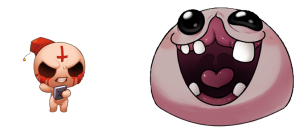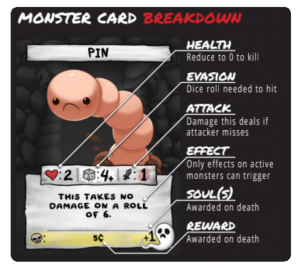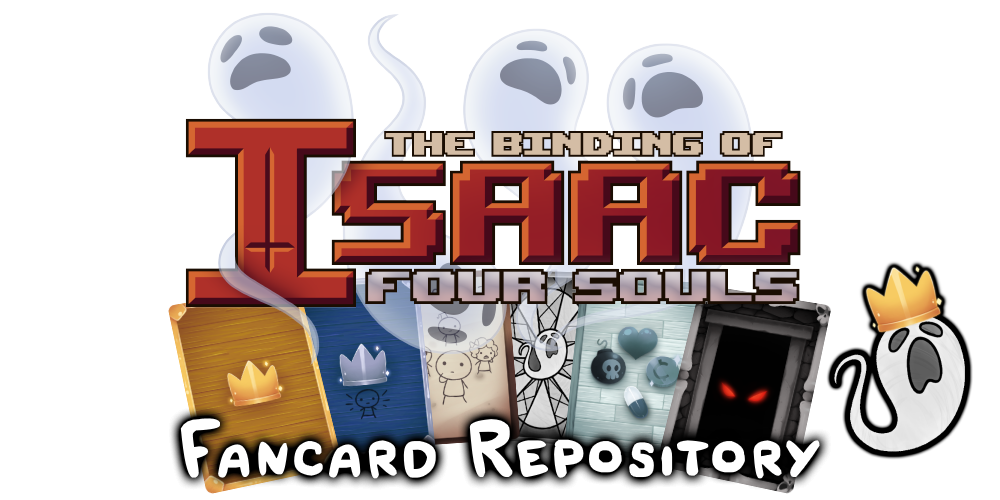Purchasing Next
Monster Death
Attacking

A player may attack once a turn during their action phase. They may attack either one of the active monsters or the top card of the monster deck. A player can only start an attack while the stack is empty (i.e. not in response to anything). Each attack consists of multiple attack rolls – the attacking player will keep rolling until either the monster or the player is dead. You can use the D8 to keep track of monster health.
- To start an attack, the player first says what they are attacking. This declaration is put on the stack. When it resolves, the attack starts and you continue to step 2. If either the player or monster dies at any time during the attack, the attack ends (see Monster Death, Player Death).
- If the player is attacking the top of the monster deck, they start by revealing the card.
- If it is a monster card, the player puts it into an active monster slot of their choice and then continues to step 3.
- If it is a non-monster card the player must play it, then they get priority. Revealing a non-monster card from the top of the deck still counts as a player’s attack for the turn.
- If the player is attacking one of the current active monsters they go straight to step 3.

- Next the player makes an attack roll with a six-sided dice (see Dice Rolls).
- If the roll resolves as a number less than the monster’s evasion, the attack misses and combat damage equal to the monster’s attack is put on the stack directed at the player. The active player gets priority.
- If the roll resolves as a number equal to or greater than the monster’s evasion, the attack hits and combat damage equal to the player’s attack is put on the stack directed at the monster. The active player gets priority.
- The combat damage on the stack resolves, and either the player or monster takes combat damage. Any effects that trigger off of this damage are put on the stack. After these effects resolve, if both the player and the monster are still alive, the player goes back to step 3 and rolls the dice again. Otherwise, if either the player or monster is dead, combat ends.
- When a monster is killed, the active player gains rewards for its death and that monster card is placed face up on the top of the monster deck discard pile (see Monster Death).
- If the active monster is killed and an active monster slot is empty, reveal the top card of the monster deck and place it face up in that empty slot (see Refilling Slots).
- If another player kills a monster during another player’s turn via items or loot cards, it is still the active player that gets any rewards for that monster dying.
- All damage done to players and monsters is healed at the end of any player’s turn.
Number of Attacks
Normally, a player may attack once a turn during their action phase. There are however some exceptions to this:
- Some effects can force a player to make an attack, and in these cases the player must make any forced attacks at the next possible time that turn (i.e. the next time they have priority during their action phase while the stack is empty). It is possible for a player to be forced to make an attack after they have already made an attack that turn; in these cases the player will be able to make the additional forced attack even though they would not have been able to attack again otherwise.
- There are a number of item, loot card, and monster effects that can give a player additional attacks.
- Killing a monster outside of combat with an effect does not count as an attack.
Related FAQs
Attacking and Monster Slots
What do you do if you are forced to fight the top card of the monster deck, but all active monsters cannot be covered?
The print and future versions of cards like Exposito that force a player to attack the top of the monster deck will have an 'if able' added to the end of that effect to indicate that if all active monster slots have monsters in them that can't be covered then that effect fizzles and the active player may choose to attack one of the active monsters. The ruling remains the same even with the old wording - if there are no active slots that the top card of the monster deck could be drawn into, the effect forcing a player to attack the top of the monster deck will fizzle.
What do you do if you attack the top of the monster deck and it is a monster that can’t be attacked?
Certain monsters such as Stoney and Death's Head can't be attacked. If a player attacks the top of the monster deck and reveals a monster that can't be attacked, the monster is placed into an active slot and the attack fizzles. This does still count as that player's attack for the turn.
Can you still deal damage to monsters that can’t be attacked with loot card and item effects?
Yes. Whilst monsters like Stoney and Death's Head can't be attacked, they can still be damaged (and potentially killed) by loot card and item effects (e.g. bombs, Mr Boom, Golden Razor Blade).
What happens if a player kills a monster or boss during another player’s turn?
The active player always gains the rewards of any monster being killed, regardless of how the monster was killed. If the monster killed was a boss the active player also gains the soul.
What happens if a player and a monster both take lethal damage at the same time?
Normally the rules of the stack mean that one of the effects or dice rolls that would kill either the player or the monster resolves first, and thus combat will be cancelled before the other can die. There are a few exceptions, however, with a number of effects that deal damage to both a player and a monster at the same time, such as Lust's effect. In these rare cases where both the player and the monster die at the same time you resolve the monster’s death first, then the player’s.
If I’m attacking a monster that has an effect that deals damage to me on a roll of 6 and I’m at 1HP and roll a 6 that would kill the monster, who dies first?
The monster’s triggered effect would be added to the stack and would resolve before the attack roll that would deal the final damage to kill the monster. Combat ends when either the player or monster dies, and the unresolved attack roll on the stack would fizzle when the player dies. The monster would therefore not die in this scenario even after the player does.
The Stack
If I decide to attack the top card of the monster deck or buy the top card of the treasure deck and someone responds by rearranging or otherwise altering the top card(s) of that deck, can I take back my attack on/purchase from the deck?
No. Once a player has declared what they are attacking or purchasing they must attack/purchase that way when the declaration resolves regardless of what other players may do before then.
What happens if I’m attacking a monster that has a triggered effect on a specific roll and I also have an item that triggers on that same roll?
Monster effects are added to the stack first, followed by any other triggered effects. The effects will then resolve in reverse order like normal.
Can I respond to a dice roll that would have killed me by using an item or loot card that cancels my attack to avoid dying?
Yes. The item or loot card effect would be put on the stack above the dice roll and would therefore resolve first, cancelling the attack before the dice roll would resolve and kill the player.
Ask a question
Would you like a rule clarified? Do you think you've found an edge case? Have you checked on all relative pages to ensure the question hasn't been answered already?
If so, feel free to submit a question to our Card Tzar! He may decide to edit the article to clarify the issue, or to add an FAQ to clarify your question.
Purchasing Next
Monster Death

